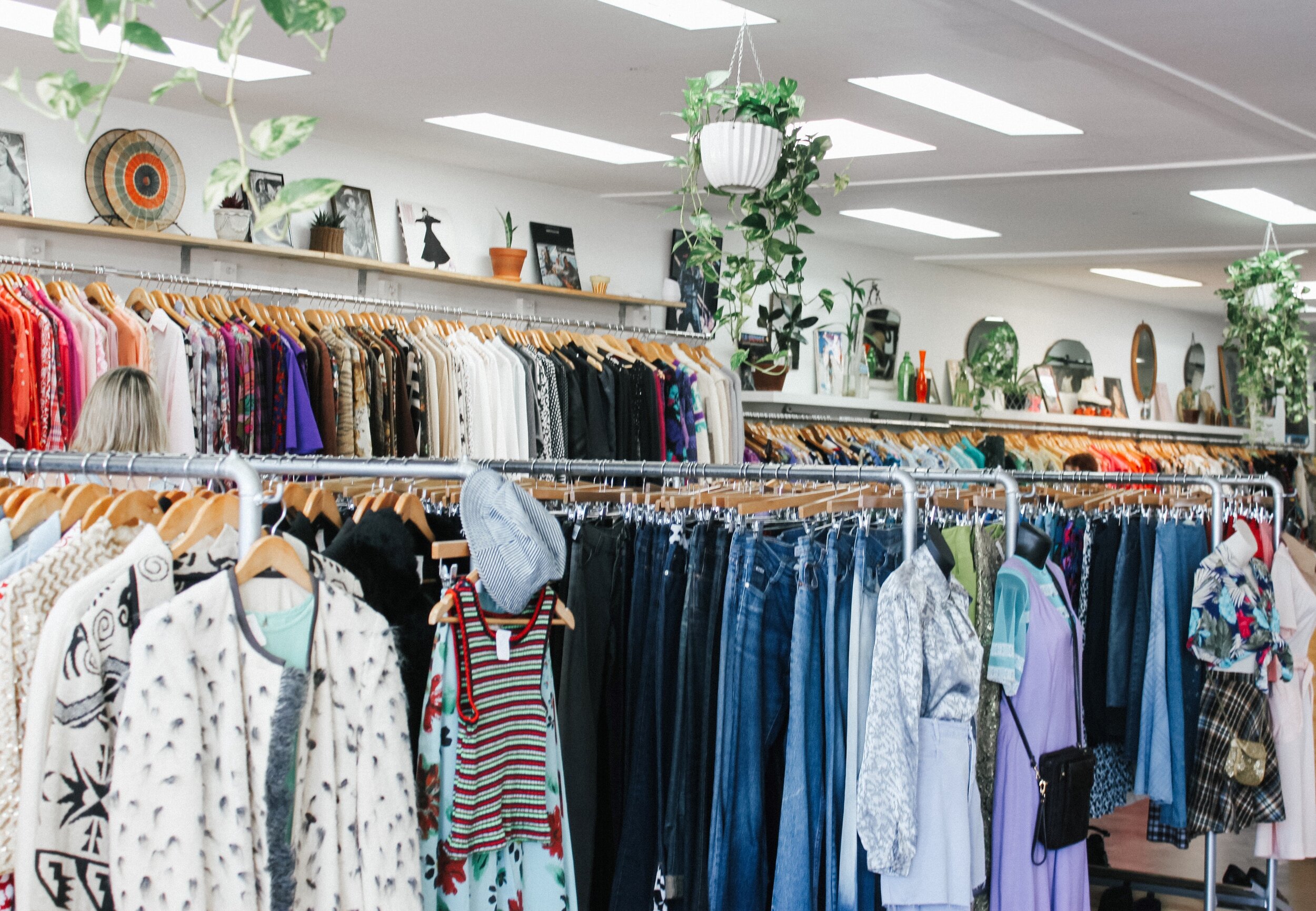Photo courtesy Lauren Fleischmann.
I’m beginning to wander if the Global South is the new landfill for Western countries. Do you ever think about what happens to your clothes when you’re done with them? And when you donate to thrift stores, do you think about where your clothes will eventually end up after they’ve been re-used? I probably wouldn’t, however, walking into a thrift store at age 15 in an African country was the eureka moment that forever changed my life and how I perceived secondhand (preloved) clothing.
Photo courtesy Prudence Earl
Thrift stores and fashion waste
Fast fashion is often poorly made, low quality, mass-produced clothes made from synthetic textiles. They are a major pollutant and can often end up in landfill not too long after manufacture. Fast fashion overconsumption is the primary reason why fashion is one of the most polluting industries in the world. Because they are not always sellable, charity thrift stores are forced to dispose of them, which can have a devastating impact on their budgets. Australian charitable recycling organisations are spending approximately $13 million per year sending unusable donations to landfill. The other option is to send them to emerging countries in places like Asia and Africa. The British charity shop, Oxfam, declared that a minimum of 70% of secondhand garments donated to them ends up in Africa.
Secondhand clothing from the Global North to the Global South
For decades, countries in the Global North such as Australia, the U.S., the U.K. have been sending unwanted secondhand clothes to countries in the Global South. Most of these clothes are the leftovers that op shops (thrift stores) cannot sell. Data from the Australian Bureau of Statistics in 2016 – 17 for instance revealed that Australian exports 93,502,966 kilos of “worn clothing and other work textiles articles”. Direct exports from charities accounted for two thirds of this figure.
Photo courtesy M. Yusuf / Voice of America
My personal experience
One of my first and most memorable thrift store experiences was in Nigeria at age 15. Like other preloved stores in Africa, they too received secondhand clothes from Western countries. It was the day my career in sustainable fashion began. I loved finding vintage and contemporary fashion treasures and relished the opportunity to play dress up with an eclectic range of garments at thrift stores. However, a sense of unease gradually began to stir within me because of a couple of things I observed. These imported, affordable clothes were stifling the growth of the local fashion industry. Secondly, there was so much stock that it was visibly polluting the environment. At the end of their life cycle, these clothes would end up in mountains of trash near residential areas, along with other household trash. Landfills were rarely an option in these communities.
Banning secondhand clothing
In 2015, East Africa imported $151 million worth of apparel, mainly from the U.S. and Europe. Countries such as Kenya, Tanzania, South Sudan, Burundi, Rwanda and Uganda have been phasing out secondhand apparel with the intent of an eventual total ban. They believe secondhand clothing undermines their dignity and the development of nascent textile industries in their nations. Despite being major cotton producers, a significant portion of the population within countries such as Burkina Faso, Nigeria and Mali depend on secondhand clothes. African countries have been exporting raw materials and less often, finished products. According to the McKinsey Consultancy, within a decade, East Africa could have the capability to export garments (as finished products) worth up to $3 billion annually.
The quandary of African countries
In opposition to the East African clothing ban, the Office of the United States Trade Representative in 2017 threatened to remove four East African countries in the list of the Africa Growth and Opportunity Act. It gives preferential trade benefits to African countries for the purpose of lifting trade and economic growth across sub-Saharan Africa. Part of the weight behind the American opposition was the Secondary Materials and Recycled Textiles Association (SMRTA), a band of 40 used clothing exporters with 40,000 American jobs within it. SMRTA said that the clothing Americans threw away would end up in U.S. landfills and damage the environment in the U.S.
Authorities in African countries viewed the threat as an example of a Global North country bullying countries in the Global South that are trying to cultivate a more self-sufficient, thriving economy. Situations like this place emerging countries in a dilemma over balancing protectionism with the perils of damaging their diplomatic connections and relationship with the global economic network.
In a country like Nigeria, even though the government has technically banned secondhand clothing, the rules are not thoroughly being enforced. The conundrum is that it has not yet established a foundation of infrastructure and facilities that will empower local businesses to compete with Western fast fashion, particularly secondhand imports.
Image courtesy Wong Maye-E, Associated Press, The New York Times.
Textile pollution
And then there’s the issue of pollution. Many textile recycling businesses and charities take pride in their zero-waste status by shipping all leftover clothing to developing countries. In some regards, this notion is akin to the SMRTA principle which believes African nations should accept their unwanted clothing to keep them out of American landfills and to protect the U.S. environment from damage. All of these Western organisations seem to have no issues with sending over their ‘trash’ to pollute African environments and fill up African landfills (or lack thereof).
Toxic groundwater
Beyond just littering the environment and the trash dumps in emerging countries, synthetic textiles release toxic groundwater when it rains. They are not biodegradable. The buildup of chemicals that come out of these synthetics after years of rainfall produces toxic ground water that leaks into the soil, damaging its fertility and natural ecology.
Moreover, when toxic ground water stays at the surface of the ground, it evaporates with the chemicals into rain clouds which becomes acid rain. Acid rain pours back down again and spreads over a much wider surface area, repeating the soil damage process.
Water is of course a life source used by people in the local communities for household and agricultural purposes. Toxic groundwater and acid rain flow into local water bodies and can be hazardous to people who depend on it. Acid rain also contributes to the extinction of specific species because it can cause health problems or death when ingested. It changes the pH levels of water bodies which impacts marine wildlife.
Another landfill solution to the problem of oversupply
I’m not entirely recommending they should suddenly stop shipping secondhand clothes to Africa, Asia and other places. It’s just not environmentally sustainable for those countries to have synthetic textiles in their landfills and trash dumping areas. It’s polluting the environment in emerging countries who did not create the pollution problem in the first place. Yet they’re having to deal with the repercussions. At the end of the day, countries in the Global South have become another landfill for countries in the Global North. And this is not a solution to the problem of oversupply and overconsumption. Furthermore, it contributes to climate change.
Where jobs are concerned, it curbs the creation of new jobs in poorer countries of the South that are attempting to build a thriving manufacturing economy by establishing local fashion industries.
Photo courtesy Association for Free Research and International Cooperation.
What can be done
Less fast fashion equates to less waste. Addressing the issue at the root cause by minimising the oversupply and overconsumption of fast fashion will have a positive domino effect. As a consumer, before you purchase any garment, think about how many times you’ll use it and how long you will keep the item. If it’s short term, then consider hiring, renting or borrowing instead.
Countries that do not need to import secondhand clothing can decide if and how they will move forward in developing their own textile and clothing manufacture industries. In the latter, governments will need to address issues such as the requirement for local manufacturers to have access to sufficient funding, raw material, energy and liveable wages. In addition, garments should be made from natural textiles that also cater to the entire range of consumer budgets.
To be fair, some of the secondhand recycling organisations send clothing to help impoverished communities that cannot afford clothing. This is certainly admirable and a highly appropriate way of re-purposing these clothes. However, what if we made this a short-term strategy whilst we applied our focus on developing sustainable long-term systems to ensure those communities became economically independent within a specific time frame? This way we can break these cycles of poverty, end dependency and uplift global communities.
♥ Nina Gbor
Instagram: @eco.styles
References:
https://afric.online/7730-second-hand-clothes-a-threat-to-african-textile/
https://www.nacro.org.au/data-on-australian-exports-of-used-clothing/
https://manrags.com.au/circular-economy/the-solution/greenhouse-gases/
https://www.nytimes.com/2017/10/12/world/africa/east-africa-rwanda-used-clothing.html




